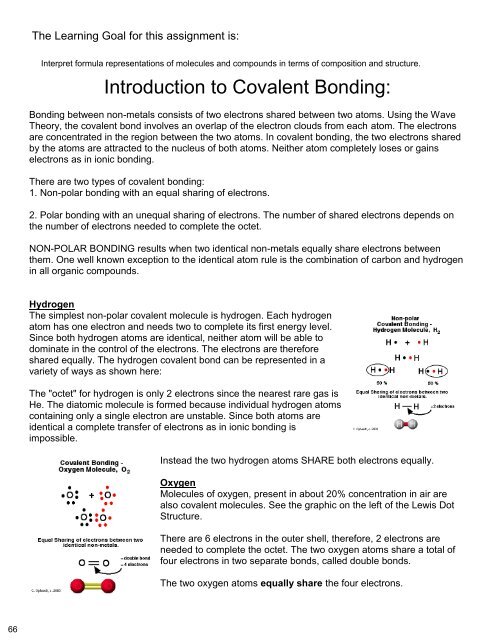Create successful ePaper yourself
Turn your PDF publications into a flip-book with our unique Google optimized e-Paper software.
Here's another:<br />
K2O is potassium oxide<br />
Naming Ionic Compounds Containing Transition Metals<br />
A transition metal is a metal that can use the inner shell before using the outer shell to bond. These<br />
are the elements in the middle of the periodic table - things like zinc, iron and copper. Naming<br />
polyatomic ionic compounds that have transition metals in them is also fairly easy. It follows the<br />
same naming rules as the simple binary compounds, but with an extra rule added in. So, you still<br />
name the cation first, followed by the anion with the suffix -ide added to the end of it.<br />
The new rule is that transition metals form more than one ion, so this has to be accounted for in the<br />
naming. We do this by using Roman numerals to denote which ion it is. The Roman numeral will<br />
equal the charge on the ion. For instance, Fe 2+ is iron (II). Fe 3+ is iron (III).<br />
When compounds are formed with these metals, the different ions still have to be accounted for. If I<br />
told you the compound was iron chloride, that wouldn't give you the full story. You wouldn't know if it<br />
was iron (II) or iron (III), which means you don't know how many chlorine atoms are in the compound<br />
to bond with the iron, since two chlorines would be needed for iron (II) and three for iron (III). If I<br />
instead told you that the compound was iron (II) chloride, you would know that it was Fe 2+ in there,<br />
which means you have two chlorine atoms bonding with it. The formula would be FeCl2. If I said it<br />
was iron (III) chloride, the formula would be FeCl3.<br />
Naming Polyatomic Ionic Compounds<br />
A polyatomic ionic compound is a compound made up of a polyatomic ion, which is two or more<br />
atoms bonded together, and a metal. Naming polyatomic ions is harder, but doable. First, name the<br />
cation, which is just the name of the element. Next, name the anion. This gets trickier.<br />
Notes Section:<br />
AB+ CD<br />
AD + CB<br />
The AB will always have to be a Cation while on the other hand the Cd will always be an anion.<br />
This is like the equation which will help you name the compound name. By following the step of fist<br />
adding your two things together. Furthermore, then you swap the order by putting the A with d and<br />
Putting c with B. Then you must remember that there sub level switches to the other Element<br />
Example; Fe2C3<br />
Your answer would be actually in reverse due to the reasoning that its supposed to be flipped.<br />
So, the answer would be: Fe3C2<br />
Finding name of compound Example; Aluminum Iodine d+ Mercury (ii) chloride<br />
You first look at the valence electrons and ho much it would need to become neutral unless they<br />
provide you with a roman numeral you must use that as the sub number.<br />
Al 3 + I 1- 1. add 3+ in order make it stable. Hg 2+ Cl 1. Add 2 to power because it says<br />
ALI3 2. We flip the sub levels so it opposite HgCl2 2, we repeat the same steps the last<br />
Lastly, we Turn the Ab+C formula to AD CB to get final result<br />
64



